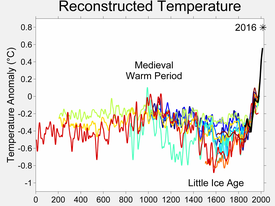From Wikipedia, the free encyclopedia
The Medieval Warm Period (MWP), Medieval Climate Optimum, or Medieval Climatic Anomaly was a time of warm climate in the North Atlantic region that may also have been related to other climate events around the world during that time, including in China[1] and other countries,[2][3][3][4][5][6][7] lasting from about AD 950 to 1250.[8] It was followed by a cooler period in the North Atlantic termed the Little Ice Age. Some refer to the event as the Medieval Climatic Anomaly as this term emphasizes that effects other than temperature were important.[9][10]Despite substantial uncertainties, especially for the period prior to 1600 when data are scarce, the warmest period of the last 2,000 years prior to the 20th century very likely occurred between 950 and 1100, but temperatures were probably between 0.1 °C and 0.2 °C below the 1961 to 1990 mean and significantly below the level shown by instrumental data after 1980. Proxy records from different regions show peak warmth at different times during the Medieval Warm Period, indicating the heterogeneous nature of climate at the time.[11] Temperatures in some regions appears to have matched or exceeded recent temperatures in these regions, while globally the Medieval Warm Period was cooler than recent global temperatures.[8]
Initial research
The Medieval Warm Period (MWP) is generally thought to have occurred from about AD 950–1250, during the European Middle Ages.[8] In 1965 Hubert Lamb, one of the first paleoclimatologists, published research based on data from botany, historical document research and meteorology combined with records indicating prevailing temperature and rainfall in England around 1200 and around 1600. He proposed that "Evidence has been accumulating in many fields of investigation pointing to a notably warm climate in many parts of the world, that lasted a few centuries around A.D. 1000–1200, and was followed by a decline of temperature levels till between 1500 and 1700 the coldest phase since the last ice age occurred."[12]The warm period became known as the MWP, and the cold period was called the Little Ice Age (LIA). However, this view was questioned by other researchers; the IPCC First Assessment Report of 1990 discussed the "Medieval Warm Period around 1000 AD (which may not have been global) and the Little Ice Age which ended only in the middle to late nineteenth century."[13] The IPCC Third Assessment Report from 2001 summarised research at that time, saying "…current evidence does not support globally synchronous periods of anomalous cold or warmth over this time frame, and the conventional terms of 'Little Ice Age' and 'Medieval Warm Period' appear to have limited utility in describing trends in hemispheric or global mean temperature changes in past centuries".[14] Global temperature records taken from ice cores, tree rings, and lake deposits, have shown that, taken globally, the Earth may have been slightly cooler (by 0.03 degrees Celsius) during the 'Medieval Warm Period' than in the early and mid-20th century.[15][16]
Palaeoclimatologists developing region-specific climate reconstructions of past centuries conventionally label their coldest interval as "LIA" and their warmest interval as the "MWP".[15][17] Others follow the convention and when a significant climate event is found in the "LIA" or "MWP" time frames, associate their events to the period. Some "MWP" events are thus wet events or cold events rather than strictly warm events, particularly in central Antarctica where climate patterns opposite to the North Atlantic area have been noticed.

No comments:
Post a Comment